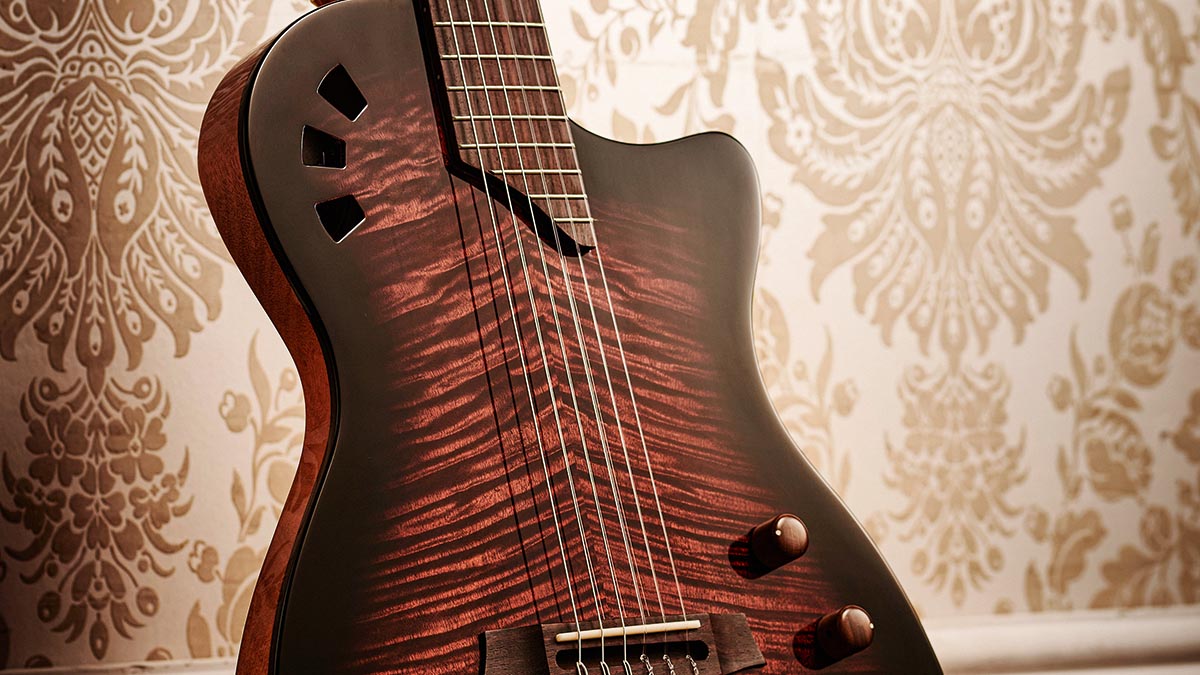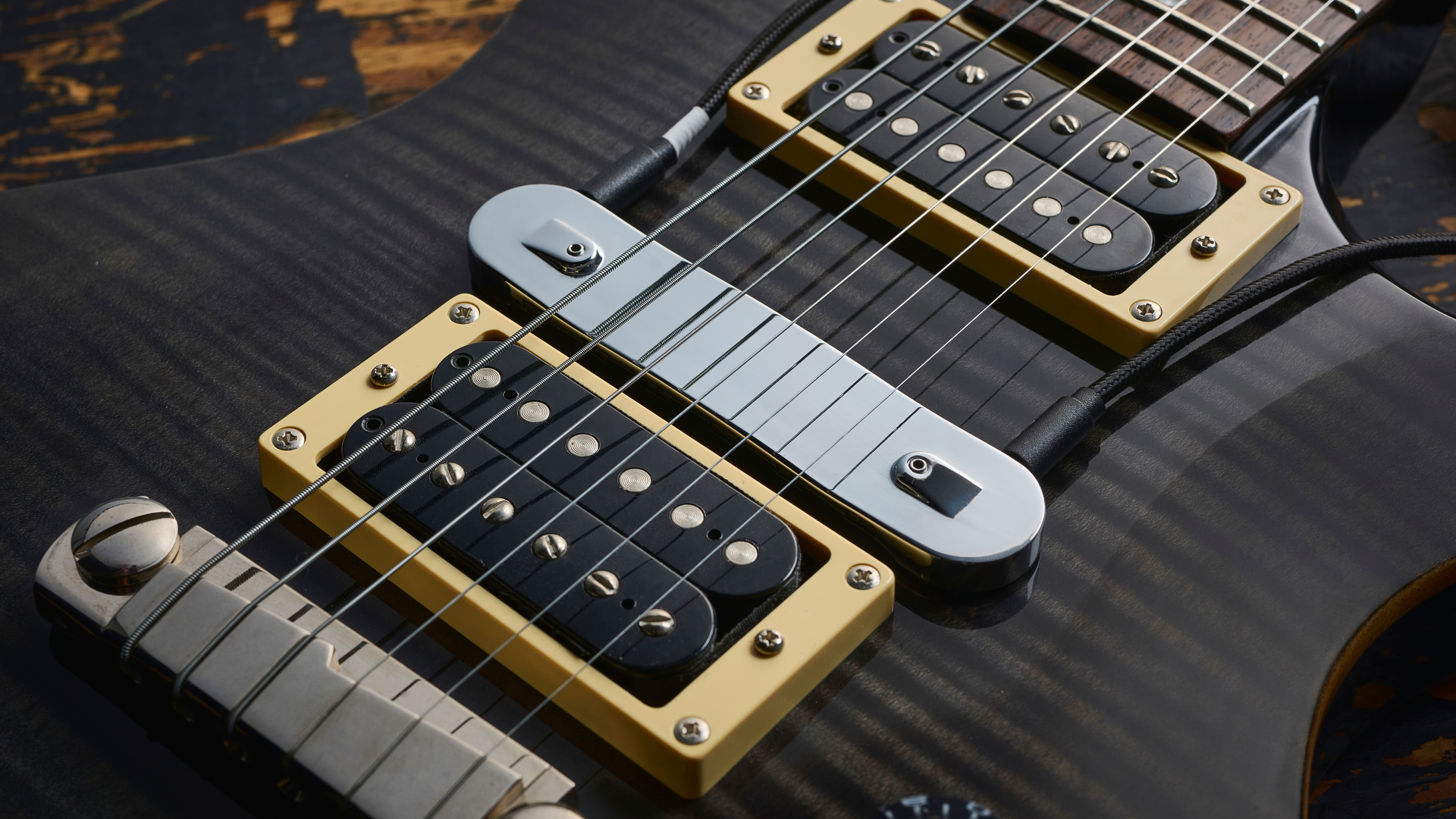Guitar World Verdict
All in, a great and pretty affordable stage-aimed guitar that’s no slouch when it comes to home recording
Pros
- +
Neat, compact thinline design.
- +
Tidy build.
- +
Excellent playability.
- +
Very good amplified sounds, especially at this price.
Cons
- -
Our model had rough fret tops, though there is an easy fix.
You can trust Guitar World
Amplifying any acoustic guitar, if you can’t use microphones, can be fraught with difficulties, not least for those of us who have to cart our own PAs to gigs while acting as guitarist, roadie and sound engineer. And although acoustic guitar pickup technology is now hugely refined, battling with onstage feedback from your acoustic box – especially if you’re a part of a band – can certainly be difficult to manage.
Creating a thin-bodied electro is far from a new idea, but it does answer some questions, offering a stage-aimed instrument with a much smaller soundbox – and, therefore, much less acoustic volume – that can work in many environments.
Like many large-scale makers, Córdoba already has that style covered, with guitars such as its affordable thinline C5-CET or upper-tier 55FCE Negra. The new Stage, though, takes the concept even further.
Not only is this model a thinline electro, it also has a narrower-than-classical neck width, with a 406mm (16") ’board radius, and instead of a conventional soundhole we have three small ports on the upper bout – in the style of Córdoba’s ‘arches’ logo, inspired by the Mezquita Cathedral in Córdoba, Spain.
In complementary fashion, three rotary controls for the electro system are mounted on the face of the guitar. You can see why Córdoba feels this is its first ‘electric’ nylon-string.
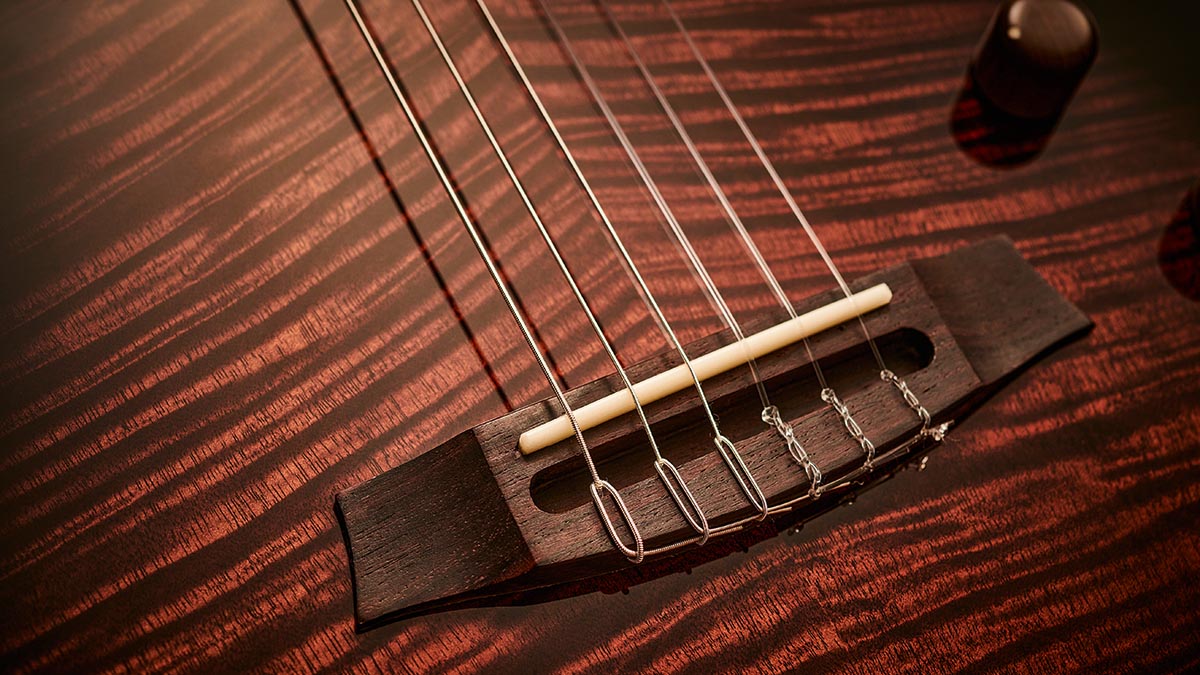
As we’ve reported before, Córdoba is the Spanish-sounding brand (founded in 1997 in Santa Monica, California, and created by the Córdoba Music Group, who also owns Guild) for what is now a huge range of nylon-strings catering to everyone from beginners up to pretty serious-level classical and flamenco players.
Its instruments are made in various locations, from China to Spain, and although our Stage has no country of origin indication – simply “Designed in California, USA” – the UK distributor confirms that it’s China.
With its far from lofty price in mind (which includes a very good gigbag made from recycled nylon), what we see here is pretty impressive craft. The single-cut slab-body design nods to Taylor’s steel-string T5z, and here the two-piece mahogany back is extensively chambered.
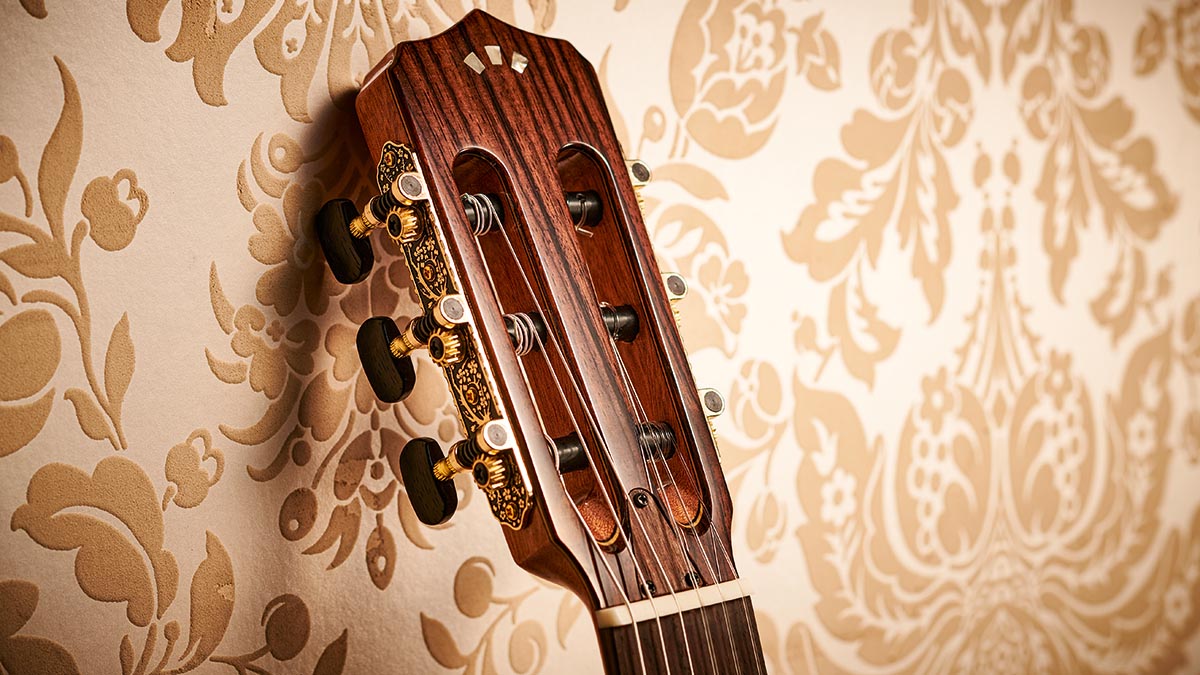
It’s topped with a solid spruce braced front and faced with an attractive flamed maple veneer in a pretty moody Edge Burst, while the back, sides and neck have a vibrant, slightly orange-y light brown clear finish. There’s a light rib cage contour on the back, and the slightly rounded neck heel actually looks like it was inspired by PRS’s Singlecut.
The neck has a single-piece heel stack and the slotted headstock is cleverly and virtually invisibly spliced on, one of the few elements that recall a classical’s design, along with that tie-block bridge. It also uses a two-way truss rod, adjustable behind the nut like many more modern electro nylon-strings.
According to Córdoba’s launch PR, the Stage’s pickup system was co-developed with Fishman and uses both a body sensor (actually two small dot sensors stuck to the top just behind the bridge) and an under-saddle transducer; the lower of the three rotary controls, Body Blend, lets you blend the body sensor in with the transducer. The front control is volume and the middle EQ control moves from ‘flat’ to mid-scooped, emphasizing the treble and bass.
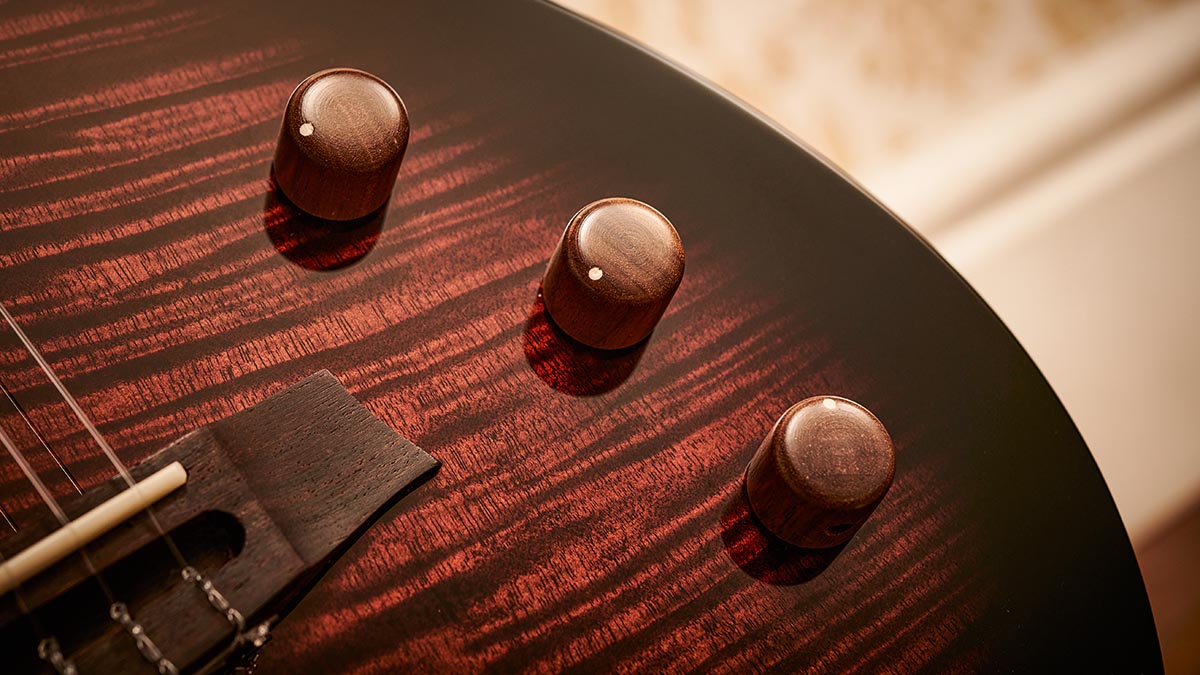
Feel & Sounds
With its solidbody depth and overall size, the Stage feels considerably more compact played seated than the much deeper body of a standard electro, such as the Córdoba GK Pro we used as a reference.
There is a relatively small difference in the necks, both in width and depth, although in the hand the GK Pro’s neck certainly feels bigger. There’s less difference in the all-important string spacing but enough to make the Stage initially feel slightly cramped for traditional players – less so for those coming from a steel-string acoustic or electric.
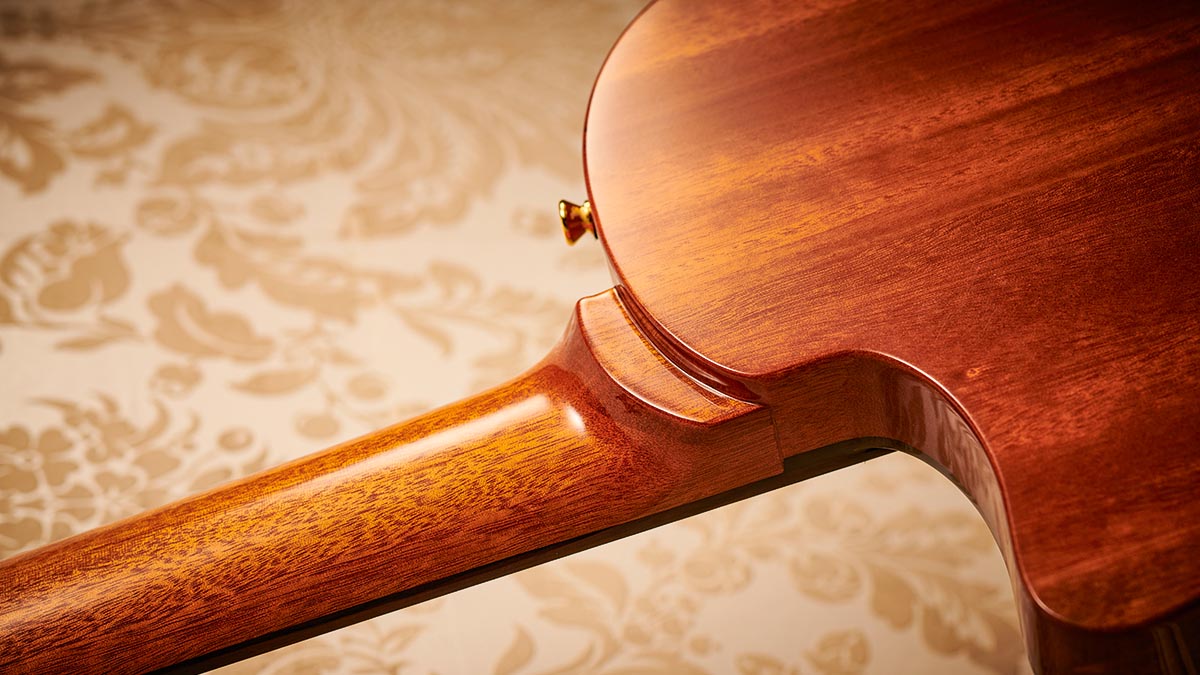
This crossover style means you can use a pick, not just your fingers. The Stage feels particularly good for jazzier or Latin styles, and its 14-frets-to-the-body neck join is more steel-string like. The strap button is placed on the upper shoulder to augment the button on the base, while the output jack is side-mounted, again a very electric guitar-like feature. Strapped on, it feels light but not insubstantial, and it balances well.
By design, there’s a little acoustic volume but enough for solo practice, and while there’s a lot less body to the voice than our GK Pro, there’s a nice quick and bright-edged attack.
Overall, it’s a good player. However, like many lower-priced nylon-strings, the fret tops are left a little rough – something that could easily be fixed with some polishing. You won’t be bending like a steel-string, of course, but it’s just good craft.
The actual voicing when plugged in really captures that note attack, and the under-saddle sounds crisp and clear. This is especially true with the Body Blend control fully anti-clockwise, with none of the body sensors being voiced and the EQ turned in a similar direction to the flat position.
‘Body’ is accurate as that’s what it adds to the sound; the top becomes a tap plate, and the EQ control appears to add subtle crispness and low-end lift with a slight dip in the mids. It’s actually a very realistic, almost mic’d-sounding classical voice, perhaps aimed towards the more percussive flamenco, rather than the somewhat clichéd rounded nylon voice.
You might get more adjustment via a side-panel band EQ, but the front-placed controls are very fast to use and a lot less fiddly. The Stage also records direct into a DAW really well, not least with those body sensors adding considerable realism to the under-saddle sound.
Verdict
This nylon electro is well named, clearly designed to give a live performer a rather good and quite authentic nylon-string voice with complete absence of feedback in all but high-volume settings.
Aside from rather scratchy fret tops, it’s well made and good looking without the bulk of a full acoustic body; the neck is much more manageable for the crossover player, too.
All in, a great and pretty affordable stage-aimed guitar that’s no slouch when it comes to home recording: perfect to add some Latin vibes to those dance tracks.
Specs
- PRICE: $699 / £625 (inc gigbag)
- ORIGIN: China
- TYPE: Thinline cutaway-electro nylon-string
- TOP: Solid spruce with flame maple veneer facing
- BACK: Chambered mahogany
- NECK: Mahogany, glued-in
- SCALE LENGTH: 650mm (25.6”)
- TUNERS: Gold classical style with black buttons and rollers
- NUT: Bone
- FINGERBOARD: Pau ferro, 406mm (16”) radius with side dot markers
- FRETS: 19 (plus 3 partial), medium/small
- BRIDGE: Pau ferro with bone saddle
- ELECTRONICS: Fishman/Córdoba Stage pickup system with under-saddle and body (top) sensors, volume, EQ and Body Blend rotary controls
- OPTIONS: None
- RANGE OPTIONS: Córdoba’s C5-CET (£399) is a more classic-looking thinline electro and is available with various options. Other thinline electros include the Spanish-made 55FCE (£1,649), as used by the Gipsy Kings
- LEFT-HANDERS: No
- FINISH: Edge Burst (as reviewed) – gloss polyurethane
- CONTACT: Córdoba

Dave Burrluck is one of the world’s most experienced guitar journalists, who started writing back in the '80s for International Musician and Recording World, co-founded The Guitar Magazine and has been the Gear Reviews Editor of Guitarist magazine for the past two decades. Along the way, Dave has been the sole author of The PRS Guitar Book and The Player's Guide to Guitar Maintenance as well as contributing to numerous other books on the electric guitar. Dave is an active gigging and recording musician and still finds time to make, repair and mod guitars, not least for Guitarist’s The Mod Squad.
“Among the most sought-after of all rhythm guitars… a power and projection unsurpassed by any other archtop”: Stromberg has made a long-awaited comeback, and we got our hands on its new Master 400 – a holy grail archtop with a price to match
The heaviest acoustic guitar ever made? Two budding builders craft an acoustic entirely from concrete because they “thought the idea was really funny”
